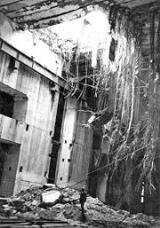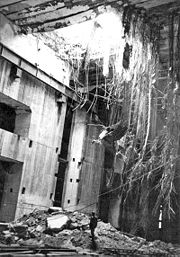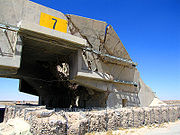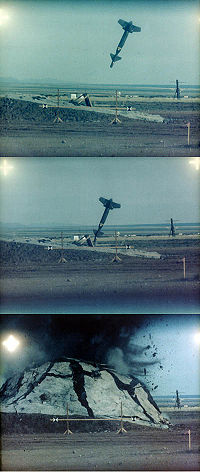
Bunker buster
Encyclopedia
A bunker buster is a bomb
designed to penetrate hardened targets or targets buried deep underground.
s were bunker-busting artillery shells, developed by German engineer August Cönders
, based on the theory of increasing sectional density to improve penetration.
They were tested in 1942 and 1943 against the Belgian Fort d'Aubin-Neufchâteau
 In World War II
In World War II
the British designer Barnes Wallis
, already famous for inventing the bouncing-bomb
, designed two bombs that would become the conceptual predecessors of modern bunker busters: the five tonne
Tallboy
and the ten tonne Grand Slam
"Earthquake" bombs
. The designs were very aerodynamic with a tail which caused them to spin. This allowed them to exceed the speed of sound as they fell from 22,000 ft (6,700 m). They had casings of high grade steel, much stronger than the typical WWII bomb so that they would survive hitting a hardened surface, or penetrate deep into the ground.
Though these bombs might be thought of as 'bunker busters' today, in fact the original 'earthquake' theory was more complex and subtle than simply penetrating a hardened surface. The Earthquake bombs were designed not to strike a target directly, but to impact beside it, penetrate under it, and create a 'camouflet
' or large buried cavern at the same time as delivering a shock wave through the target's foundations. The target then collapses into the hole, no matter how hardened it may be. The bombs had strong casings because they needed to travel through rock rather than reinforced concrete, though they could perform equally well against hardened surfaces. In an attack on the U-boat pens at Farge
two Grand Slams went through the 15 ft (4.5 m) reinforced concrete hardening — equalling or exceeding the best current penetration specifications.
The Disney Rocket-Assisted Bomb
was another WWII device to be used against U-boat pens and other super-hardened targets. Devised by Captain Edward Terrell
RNVR of the Admiralty's Directorate of Miscellaneous Weapons Development
it had a streamlined hardened case and weighed some 4,500 lb (2 tonnes) including the rocket assembly. Actual exposive content was about 500 lb (226.8 kg). The bomb was dropped from 20000 ft (6,096 m). At 5,000 ft (~1,500 m) a barometric fuze
fired the rockets in the tail to give it a velocity at impact of up to 2,400 ft/second (730 m/s). It was first used by the USAAF's 92nd Bomb Group on 10 February 1945 on S-boat pens at IJmuiden, Netherlands
, one bomb under each wing of nine B-17 Flying Fortresses. On that occasion a single direct hit was scored. A total of 158 "Disney Bombs" were used operationally by the end of hostilities in Europe.
against an underground command center near Kanggye.
 During Operation Desert Storm (1991) there was a need for a deep penetration bomb similar to the British weapons of WWII, but none of the NATO air forces had such a weapon. As a stop-gap, some were developed over a period of 28 days, using old 8 inch (203 mm) artillery barrels as casings. These bombs weighed over two tons but carried only 647 lb (293.5 kg) of high explosive. They were laser-guided and were designated "Guided Bomb Unit-28 (GBU-28
During Operation Desert Storm (1991) there was a need for a deep penetration bomb similar to the British weapons of WWII, but none of the NATO air forces had such a weapon. As a stop-gap, some were developed over a period of 28 days, using old 8 inch (203 mm) artillery barrels as casings. These bombs weighed over two tons but carried only 647 lb (293.5 kg) of high explosive. They were laser-guided and were designated "Guided Bomb Unit-28 (GBU-28
)", and were effective.
An example of a Russia
n bunker buster is the KAB-1500L-Pr. It is delivered with the Su-24M and the Su-27IB aircraft. It is stated to be able to penetrate 10-20 m of earth or 2 m of reinforced concrete. The bomb weighs 1500 kg (3,306.9 lb), with 1100 kg (2,425.1 lb) being the high explosive penetrating warhead. It is laser guided
and has a reported strike accuracy of 7 m (23 ft) CEP.
The US has a series of custom made bombs to penetrate hardened or deeply buried structures:
More recently, the US has developed the 30,000-pound GBU-57
.
is the same as a classic armor-piercing bomb: a combination of timer and a sturdy dynamic propeller on the rear of the bomb. The fuze
is armed when the bomb is released, and detonates when the propeller stops turning and the timer has expired.
Modern bunker busters may use the traditional fuze, but some also include a microphone
and microcontroller
. The microphone listens, and the micro controller counts floors until the bomb breaks through the desired numbers of floors.
ATK is working on a Hard Target Void Sensing Fuze (HTVSF) for 2000 and 5000 pound weapons to explode when they reach an open space in a deeply buried bunker.
 The extra speed provided by a rocket motor enables greater penetration of a missile-mounted bunker buster warhead. To reach maximum penetration (Impact depth
The extra speed provided by a rocket motor enables greater penetration of a missile-mounted bunker buster warhead. To reach maximum penetration (Impact depth
), the warhead may consist of a high-density projectile only. Such a warhead carries more energy than a warhead with chemical explosives (kinetic energy of a projectile at hypervelocity
).
Bomb
A bomb is any of a range of explosive weapons that only rely on the exothermic reaction of an explosive material to provide an extremely sudden and violent release of energy...
designed to penetrate hardened targets or targets buried deep underground.
Germany
Röchling shellRöchling shell
Röchling shells were bunker-busting artillery shells, developed by German engineer August Cönders during World War II, based on the theory of increasing sectional density to improve penetration....
s were bunker-busting artillery shells, developed by German engineer August Cönders
August Cönders
August Cönders was a German engineer working for Röchling Stahlwerk AG during World War II.He designed the Röchling Shell and the V-3 cannon.- References :...
, based on the theory of increasing sectional density to improve penetration.
They were tested in 1942 and 1943 against the Belgian Fort d'Aubin-Neufchâteau
Fort d'Aubin-Neufchâteau
The Fort of Aubin-Neufchâteau is a Belgian fortification located near Neufchâteau. The fort was built in the 1930s as part of the fortified position of Liège, augmenting the twelve original forts built to defend Liège in the 1880s with four more forts closer to the Belgian frontier with Germany...
United Kingdom

World War II
World War II, or the Second World War , was a global conflict lasting from 1939 to 1945, involving most of the world's nations—including all of the great powers—eventually forming two opposing military alliances: the Allies and the Axis...
the British designer Barnes Wallis
Barnes Wallis
Sir Barnes Neville Wallis, CBE FRS, RDI, FRAeS , was an English scientist, engineer and inventor. He is best known for inventing the bouncing bomb used by the RAF in Operation Chastise to attack the dams of the Ruhr Valley during World War II...
, already famous for inventing the bouncing-bomb
Bouncing bomb
A bouncing bomb is a bomb designed specifically to bounce to a target across water in a calculated manner, in order to avoid obstacles such as torpedo nets, and to allow both the bomb's speed on arrival at the target and the timing of its detonation to be pre-determined...
, designed two bombs that would become the conceptual predecessors of modern bunker busters: the five tonne
Tonne
The tonne, known as the metric ton in the US , often put pleonastically as "metric tonne" to avoid confusion with ton, is a metric system unit of mass equal to 1000 kilograms. The tonne is not an International System of Units unit, but is accepted for use with the SI...
Tallboy
Tallboy bomb
The Tallboy or Bomb, Medium Capacity, 12,000 lb, was an earthquake bomb developed by the British aeronautical engineer Barnes Wallis and deployed by the RAF in 1944...
and the ten tonne Grand Slam
Grand Slam bomb
The Grand Slam was a 22,000 lb earthquake bomb used by RAF Bomber Command against strategic targets during the Second World War.Known officially as the Bomb, Medium Capacity, 22,000 lb, it was a scaled up version of the Tallboy bomb and closer to the original size that the bombs' inventor,...
"Earthquake" bombs
Earth quake bomb
The earthquake bomb, or seismic bomb, was a concept that was invented by the British aeronautical engineer Barnes Wallis early in World War II and subsequently developed and used during the war against strategic targets in Europe.-Development:...
. The designs were very aerodynamic with a tail which caused them to spin. This allowed them to exceed the speed of sound as they fell from 22,000 ft (6,700 m). They had casings of high grade steel, much stronger than the typical WWII bomb so that they would survive hitting a hardened surface, or penetrate deep into the ground.
Though these bombs might be thought of as 'bunker busters' today, in fact the original 'earthquake' theory was more complex and subtle than simply penetrating a hardened surface. The Earthquake bombs were designed not to strike a target directly, but to impact beside it, penetrate under it, and create a 'camouflet
Camouflet
A camouflet, in military science, is an artificial cavern created by an explosion. If the explosion reaches the surface then it is called a crater....
' or large buried cavern at the same time as delivering a shock wave through the target's foundations. The target then collapses into the hole, no matter how hardened it may be. The bombs had strong casings because they needed to travel through rock rather than reinforced concrete, though they could perform equally well against hardened surfaces. In an attack on the U-boat pens at Farge
Farge
Farge is a small port on the Weser River in the City of Bremen. The bombing of Bremen in World War II attacked Farge targets, including the oil storage and the Valentin submarine pens.-Bremen-Farge concentration camp:...
two Grand Slams went through the 15 ft (4.5 m) reinforced concrete hardening — equalling or exceeding the best current penetration specifications.
The Disney Rocket-Assisted Bomb
Disney bomb
The Disney Bomb, also known as the Disney Swish, was a rocket-assisted bunker buster bomb developed during the Second World War by the British Royal Navy to penetrate hardened concrete targets, such as submarine pens, that could resist conventional free-fall bombs...
was another WWII device to be used against U-boat pens and other super-hardened targets. Devised by Captain Edward Terrell
Edward Terrell
Edward Terrell OBE was a Liberal politician, a successful barrister and magistrate with a flair for invention; by 1940 he had registered a number of patents relating to pens, ink bottles and peeling knives...
RNVR of the Admiralty's Directorate of Miscellaneous Weapons Development
Directorate of Miscellaneous Weapons Development
The Directorate of Miscellaneous Weapons Development , known colloquially as the Wheezers and Dodgers, was a department of the Admiralty responsible for the development of various unconventional weapons during World War II...
it had a streamlined hardened case and weighed some 4,500 lb (2 tonnes) including the rocket assembly. Actual exposive content was about 500 lb (226.8 kg). The bomb was dropped from 20000 ft (6,096 m). At 5,000 ft (~1,500 m) a barometric fuze
Fuze
Fuze Beverage, commercially referred to as just Fuze , is a manufacturer of teas and non-carbonated fruit drinks enriched with vitamins. Currently the brand consists of five vitamin-infused lines: Slenderize, Refresh, Tea, Defensify, and Vitalize...
fired the rockets in the tail to give it a velocity at impact of up to 2,400 ft/second (730 m/s). It was first used by the USAAF's 92nd Bomb Group on 10 February 1945 on S-boat pens at IJmuiden, Netherlands
Netherlands
The Netherlands is a constituent country of the Kingdom of the Netherlands, located mainly in North-West Europe and with several islands in the Caribbean. Mainland Netherlands borders the North Sea to the north and west, Belgium to the south, and Germany to the east, and shares maritime borders...
, one bomb under each wing of nine B-17 Flying Fortresses. On that occasion a single direct hit was scored. A total of 158 "Disney Bombs" were used operationally by the end of hostilities in Europe.
United States
Post war the US added a form of remote guidance to the Tallboy to create the Tarzon, a 12,000-pound bomb deployed in the Korean WarKorean War
The Korean War was a conventional war between South Korea, supported by the United Nations, and North Korea, supported by the People's Republic of China , with military material aid from the Soviet Union...
against an underground command center near Kanggye.
Modern

GBU-28
The Guided Bomb Unit 28 is a 5,000 pound laser-guided "bunker busting" bomb nicknamed "Deep Throat" produced originally by the Watervliet Arsenal, Watervliet, New York. It was designed, manufactured, and deployed in less than three weeks due to an urgent need during Operation Desert Storm to...
)", and were effective.
An example of a Russia
Russia
Russia or , officially known as both Russia and the Russian Federation , is a country in northern Eurasia. It is a federal semi-presidential republic, comprising 83 federal subjects...
n bunker buster is the KAB-1500L-Pr. It is delivered with the Su-24M and the Su-27IB aircraft. It is stated to be able to penetrate 10-20 m of earth or 2 m of reinforced concrete. The bomb weighs 1500 kg (3,306.9 lb), with 1100 kg (2,425.1 lb) being the high explosive penetrating warhead. It is laser guided
Laser guidance
Laser guidance is a technique of guiding a missile or other projectile or vehicle to a target by means of a laser beam. Some laser guided systems utilise beam riding guidance, but most operate more similarly to semi-active radar homing . This technique is sometimes called SALH, for Semi-Active...
and has a reported strike accuracy of 7 m (23 ft) CEP.
The US has a series of custom made bombs to penetrate hardened or deeply buried structures:
| Depth of Penetration | Weapon Systems | |
|---|---|---|
| Penetration of reinforced concrete: 1.8 m (6 ft) | BLU-109 Penetrator | GBU-10, GBU-15 GBU-15 Guided Bomb Unit 15 is an unpowered, glide weapon used to destroy high-value enemy targets. It was designed for use with F-15E Strike Eagle, F-111 'Aardvark' and F-4 Phantom II aircraft, but the United States Air Force is currently only deploying it from the F-15E. The GBU-15 has long-range... , GBU-24, GBU-27, AGM-130 AGM-130 The AGM-130 is a missile developed by the United States of America.-Overview:The AGM-130 is a powered air-to-surface missile designed for strikes at long range against various targets... |
| Penetration of reinforced concrete: 3.4 m (11 ft) | BLU-116 BLU-116 The BLU-116 is a United States Air Force bomb, designed as an enhanced Bunker buster penetration weapon, designed to penetrate deep into rock or concrete and destroy hard targets.... Advanced Unitary Penetrator (AUP) |
GBU-15 GBU-15 Guided Bomb Unit 15 is an unpowered, glide weapon used to destroy high-value enemy targets. It was designed for use with F-15E Strike Eagle, F-111 'Aardvark' and F-4 Phantom II aircraft, but the United States Air Force is currently only deploying it from the F-15E. The GBU-15 has long-range... , GBU-24, GBU-27, AGM-130 AGM-130 The AGM-130 is a missile developed by the United States of America.-Overview:The AGM-130 is a powered air-to-surface missile designed for strikes at long range against various targets... |
| BLU-118/B Thermobaric Warhead Thermobaric weapon A thermobaric weapon, which includes the type known as a "fuel-air bomb", is an explosive weapon that produces a blast wave of a significantly longer duration than those produced by condensed explosives. This is useful in military applications where its longer duration increases the numbers of... |
GBU-15 GBU-15 Guided Bomb Unit 15 is an unpowered, glide weapon used to destroy high-value enemy targets. It was designed for use with F-15E Strike Eagle, F-111 'Aardvark' and F-4 Phantom II aircraft, but the United States Air Force is currently only deploying it from the F-15E. The GBU-15 has long-range... , GBU-24, AGM-130 AGM-130 The AGM-130 is a missile developed by the United States of America.-Overview:The AGM-130 is a powered air-to-surface missile designed for strikes at long range against various targets... |
|
| Penetration of reinforced concrete: more than 6 m (20 ft) | BLU-113 Super Penetrator | GBU-28 GBU-28 The Guided Bomb Unit 28 is a 5,000 pound laser-guided "bunker busting" bomb nicknamed "Deep Throat" produced originally by the Watervliet Arsenal, Watervliet, New York. It was designed, manufactured, and deployed in less than three weeks due to an urgent need during Operation Desert Storm to... , GBU-37 GBU-37 The GBU-37 Global Positioning System Aided Munition was developed for use with the B-2 Bomber. The bomb can penetrate hardened targets or targets buried deep underground. It became operational in 1997. It has been replaced on the B-2 by the 5000-pound GPS-aided/INS-guided GBU-28.-External links:* *... |
More recently, the US has developed the 30,000-pound GBU-57
Massive Ordnance Penetrator
The Massive Ordnance Penetrator GBU-57A/B is a project by the U.S. Air Force to develop a massive, precision-guided, "bunker buster" bomb...
.
Fusing
The traditional fuzeFuze
Fuze Beverage, commercially referred to as just Fuze , is a manufacturer of teas and non-carbonated fruit drinks enriched with vitamins. Currently the brand consists of five vitamin-infused lines: Slenderize, Refresh, Tea, Defensify, and Vitalize...
is the same as a classic armor-piercing bomb: a combination of timer and a sturdy dynamic propeller on the rear of the bomb. The fuze
Fuze
Fuze Beverage, commercially referred to as just Fuze , is a manufacturer of teas and non-carbonated fruit drinks enriched with vitamins. Currently the brand consists of five vitamin-infused lines: Slenderize, Refresh, Tea, Defensify, and Vitalize...
is armed when the bomb is released, and detonates when the propeller stops turning and the timer has expired.
Modern bunker busters may use the traditional fuze, but some also include a microphone
Microphone
A microphone is an acoustic-to-electric transducer or sensor that converts sound into an electrical signal. In 1877, Emile Berliner invented the first microphone used as a telephone voice transmitter...
and microcontroller
Microcontroller
A microcontroller is a small computer on a single integrated circuit containing a processor core, memory, and programmable input/output peripherals. Program memory in the form of NOR flash or OTP ROM is also often included on chip, as well as a typically small amount of RAM...
. The microphone listens, and the micro controller counts floors until the bomb breaks through the desired numbers of floors.
ATK is working on a Hard Target Void Sensing Fuze (HTVSF) for 2000 and 5000 pound weapons to explode when they reach an open space in a deeply buried bunker.
Missiles

Impact depth
The physicist Sir Isaac Newton first developed this idea to get rough approximations for the impact depth for projectiles traveling at high velocities.-Newton's approximation for the impact depth:...
), the warhead may consist of a high-density projectile only. Such a warhead carries more energy than a warhead with chemical explosives (kinetic energy of a projectile at hypervelocity
Hypervelocity
The term hypervelocity usually refers to a very high velocity, approximately over 3,000 meters per second . In particular, it refers to velocities so high that the strength of materials upon impact is very small compared to inertial stresses. Thus, even metals behave like fluids under hypervelocity...
).
Further reading
- Guided Bomb Unit-28 (GBU-28) BLU-113 Penetrator
- BBC: 'Bunker buster' missiles aim at Moon
- Annotated bibliography for nuclear bunker buster bombs from the Alsos Digital Library for Nuclear Issues
- Read Congressional Research Service (CRS) Reports regarding Bunker Busters
- Video against usage (produced by Union of Concerned Scientists)

